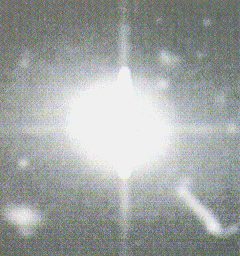

As well as radio emission from the Milky Way, pioneering radio astronomers discovered bright, point-like sources that they called "radio stars", though they seemed to bear no relation to the stars seen in visible light. For many years astronomers did not know whether they were objects inside our own Galaxy, or much further away in intergalactic space. The resolving power of radio telescopes was so poor that the positions of these sources could be measured only very roughly. That meant it was not possible to match them to objects on optical photographs of the sky. |
|
|
In the early 1950s Cambridge astronomers used an interferometer to pinpoint one of the brightest of the sources, known as Cygnus A. Optical astronomers at Palomar Observatory the photographed the area and found a strange, disturbed galaxy. Further work at Jodrell Bank revealed that the source was double, the radio emission coming from two fuzzy clouds, or "lobes", one on either side of the galaxy but at some distance from it. Through other interferometric work at Jodrell Bank, Cambridge and elsewhere it soon became clear that most of the "radio stars" were actually radio galaxies, pouring out up to a million times more energy than ordinary galaxies like our own. |
But other sources remained pointlike, even with the high resolution of the very long baselines of the Jodrell Bank interferometers. In the early 1960s some of these were identified with very faint blue star-like objects. But these were not stars. They were quasars, intensely luminous powerhouses, radiating immense amounts of energy at the very limits of the observable universe.
